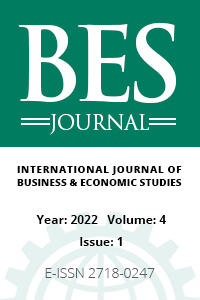The Mediating Role of Flexibility and Agility in the Effect of Supply Chain Integration on Firm Performance
The Mediating Role of Flexibility and Agility in the Effect of Supply Chain Integration on Firm Performance
Today, the concepts of supply chain integration and agile and flexible supply chain, which affect companies to increase their performance in the face of the change in competition, have come to the fore. The purpose of the current study is to develop a model that reveals the mediating role of agile supply chain and flexible supply chain in the effect of supply chain integration on firm performance, and the hypotheses are tested with the structural equation model (SEM). To this end, the research question of the current study is worded as follows; “Do the flexibility and agility of the supply chain integration have a mediating role in the relationship between the supply chain integration and firm performance?” The population of the study consists of manufacturing companies in the Free Zone and Organized Industrial Zone in the city of Mersin. A total of 238 questionnaires were applied in the current study. As a result of the analysis, it was found that the mediating role of supply chain flexibility and agility exists in the effect of supply chain integration on firm performance.
___
- Ayan, O., Ozturk, M.,G., Koseoglu, A.M. ve Colak,M.(2018). 4PL Şirketlerde Tedarik Zinciri Esnekliği: DHL Vakası. PressAcademia Procedia (PAP), V.7, 359-361.
- Benjaafar, S. and Ramakrishnan, R. (1996). Modeling, measurement and evaluation of sequencing flexibility in manufacturing systems. Int. J. Prod. Res., 34, 1195–1220.
- Blome, C., Schoenherr, T. and Rexhausen, D. (2013). Antecedents and enablers of supply chain agility and its effect on performance: a dynamic capabilities perspective, International Journal of Production Research, 51:4, 1295-1318, DOI: 10.1080/00207543.2012.728011
- Braunscheidel, M.J. (2005). Antecedents Of Supply Chaın Agılıty: An Empırıcal Investıgatıon, Doktora Tezi, New York Eyalet Üniversitesi, New York
- Chen, H., Daugherty, P., J. and Roath, A., S. (2009). Defınıng And Operatıonalızıng SupplyChaın Process Integratıon. Journal of Busıness Logıstıcs, Vol. 30, No. 1, 63-84.
- Chen, I. J. and Paulraj, A. (2004). Understanding Supply Chain Management: Critical Research And A Theoretical Framework, Int. J. Prod. Res., Vol. 42, No. 1, 131–163
- Chow, G., Heaver, T.D., and Henriksson L.E. (1995). Strategy, Structure and Performance A Framework for Logistics Research, Logistics and Transportation Review, 31,4 pp.285-308.
- Elitaş, C. ve Ağca, V. (2006). Firmalarda Çok Boyutlu Performans Değerleme Yaklaşımları: Kavramsal Bir Çerçeve. Sosyal Bilimler Dergisi, 343-370.
- Erdem, R. (2007). Örgüt Kültürü Tipleri ile Örgütsel Bağlılık Arasındaki İlişki: Elazığ İl Merkezindeki Hastaneler Üzerinde Bir Çalışma. Eskişehir Osmangazi Üniversitesi, İktisadi ve İdari Bilimler Fakültesi Dergisi, 2 (2), 63-79
- Flynn, B.B., Huo, B. and Zhao, X. (2010). The impact of supply chain integration on performance: A contingency and configuration approach. Journal of Operations Management 28, 58–71
- Gunasekaran, A.(2001). Agile Manufacturing: The 21st Century Competitive Strategy, Elsevier, UK.
- Gupta, Y. and Goyal, S. (1989). Flexibility Of Manufacturing Systems: Concepts And Measurement, European Journal Of Operational Research, Vol.43, 119-135.
- Kuruppalil, Z. (2008). Measuring Leanness and Agility of Job Shops: A Rating Scale Based on Expert Consensus. Journal of Business and Management Sciences, 2018, Vol. 6, No. 3, 112-117.
- Lee, H. L. (2004). The Triple-A Supply Chain. Harvard Business Review. October, 1-12
- Li, X., Chung,C., Goldsby, T.,J and Holsapple, C.,W.(2008). A unified model of supply chain agility: the work-design perspective. The International Journal of Logistics Management, Vol. 19 No. 3, 408-435.
- Muntaka, A. S., Haruna, A. and Mensah, H. K., (2017). Supply Chain Integration and Flexibility and Its Impact on Business Performance, International Journal of Business and Management, Vol. 12, No. 4.
- Schoenherr, T. and Swink, M. (2012). Revisiting the arcs of integration: Cross-validations and extensions. Journal of Operations Management, 30, 99–115.
- Sheffi, Y. and Rice, J. (2005). A Supply Chain View Of The Resilient Enterprise. MIT Slaon Management Review, Cambridge Vol. 47, Iss. 1, 41-48
- Slack, N. (1983). Flexibility As A Manufacturing Objective”, International Journal Of Operations And Production Management, Vol.3, No.3, 4-13
- Tallon, P. P., and Pinsonneault, A. (2011).Competing perspectives on the link between strategic information technology alignment and organizational agility: insights from a mediation model. MIS Quarterly, 35(2), 463-486
- Wahab, M. I. M. (2005). Measuring machine and product mix flexibilities of a manufacturing system. International Journal of Production Research Volume 43, Issue 18, 3773-3786
- Yıldız, B. ve Çetindaş, A. (2019). Stratejik Kaynak Kullanımının Firma Performansı Üzerindeki Etkisinde Tedarik Zinciri Çevikliğinin Aracı Rolü, Business & Management Studies: An International Journal, 6(4): 878-897
- Yusuf Y. Y., Gunesekaran A., Adeleye E. O.and Sıvayoganathan, K. (2004). Agile supply chain capabilities: Determinants of competitive objectives. European Journal of Operational Research, 159, 379– 392
- Yusuf, Y.Y., Sarhadi M., and Gunasekaran, A. (1999). Agile manufacturing: The drivers, concepts and attributes. Int. J. Production Economics, 62, 33-43.
- ISSN: 2718-0247
- Yayın Aralığı: Yılda 2 Sayı
- Yayıncı: Mesut DOĞAN
